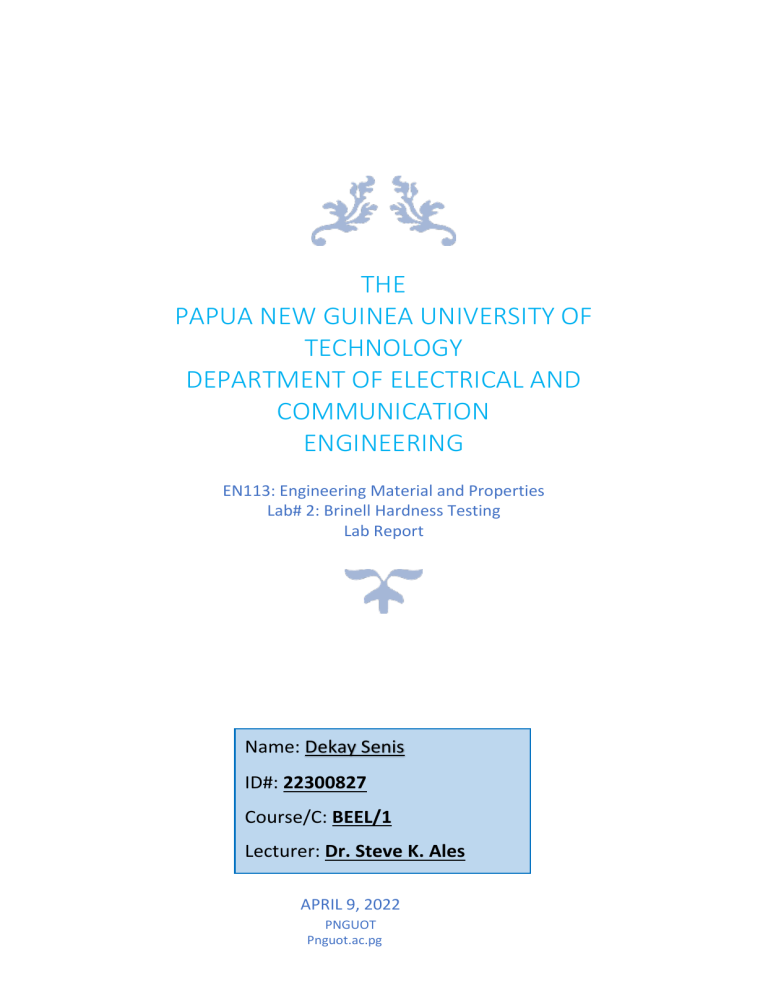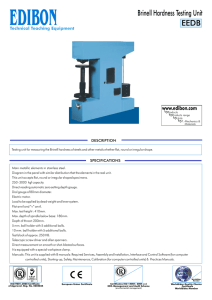
THE PAPUA NEW GUINEA UNIVERSITY OF TECHNOLOGY DEPARTMENT OF ELECTRICAL AND COMMUNICATION ENGINEERING EN113: Engineering Material and Properties Lab# 2: Brinell Hardness Testing Lab Report Name: Dekay Senis ID#: 22300827 Course/C: BEEL/1 Lecturer: Dr. Steve K. Ales APRIL 9, 2022 PNGUOT Pnguot.ac.pg CONTENT PAGE Content Page………………………………………………………………………………...1 Introduction…………………………………………………………………………………..2 Purpose………………………………………………………………………………………….2 Equipment………………………………………………………………………………………2 Background…………………………………………………………………………………….3 Procedure……………………………………………………………………………………….4 Data Analysis……………………………………………………………………………………5 Discussion………………………………………………………………………………………...5 Conclusion……………………………………………………………………………………….6 Acknowledgement and Reference…………………………………………………….7 1|Page Introduction A mechanical property of Material that may be important to consider is hardness. Hardness is the Mechanical property of a material which helps it to resist the Plastic deformation of the Material. There are four types of hard tests which are normally carried out (performed) to find the hardness (the ability of the material to resist plastic deformation) of a material for selection purposes. These tests include, Rockwell hardness test, Brinell hardness test, and the other two micro-hardness tests which are Knoop and Vickers hardness tests. Hardness tests are performed more frequently than any other mechanical test for several reasons: 1. They are simple and inexpensive—typically, no special specimen needs to be prepared, and the testing apparatus is relatively inexpensive. 2. The test is non-destructive—the specimen is neither fractured nor excessively deformed; a small indentation is the only deformation. 3. Other mechanical properties often may be estimated from hardness data, such as tensile strength. In this experiment, Brinell hardness test is performed to find the Hardness typically called the Brinell Hardness of Brass and Steel. Brinell Hardness test is one of the most important in the engineering industry and Metallurgy. It is used when the surface of the metal is very rough and hard to use another hardness test on it. There are two methods used to perform the Brinell Hardness test on a metal. These two methods are, 1. Standard Brinell hardness test Method 2. Non-Standard Brinell hardness test Method In this experiment, the Standard Brinell hardness test Method is carried out, where 250 to 1250 Kg of Hard material (steel for this experiment) and iron are used as the load. The ball indenter used has diameter of 10 mm. Purpose To determine the Brinell hardness number of steel and brass by performing Brinell Hardness Testing. Equipments Brinell Hardness Tester Ruler Testing Specimens o Brass Specimen o Steel Specimen 2|Page Background Hardness is generally considered as resistance to penetrations. The harder the material the greater the resistance to penetration. Hardness is directly related to the mechanical properties of the material. Factors influencing hardness include microstructure, grain size, strain hardening, etc.… Since in this experiment the Brinell hardness testing will be carried out, The Brinell hardness testing was invented in 1900 by August Brinell (10 October 1849-17 November 1925), who was a Swedish metallurgical Engineer. He was the creator of this method of Quantifying the surface hardness of materials (Brinell Hardness tests). Brinell hardness test determines the indentation hardness of metal materials. The Brinell test is used on materials with coarse grain or hard materials where the surface is too rough to be tested through other methods. The Brinell hardness test is suitable for a range of materials hardness’. Brinell hardness testing involves forcing a hardened steel ball (or a tungsten carbide ball for extremely hard materials) into the surface of the specimen. The ball usually has a diameter of 10mm and is pressed into the sample with a predetermined load dependent on the relative hardness of the material. E.g., 500kg for softer metals and 3000kg for hard metals. The load is applied for a defined time, usually 10-15 seconds and the impression diameter is measured using a low power microscope. The Brinell test number is calculated using this Formula: Where P- applied Load D-diameter of the ball used for indentation d-diameter of the impression produced by the ball on the work piece HB- Brinell Hardness number of the material 3|Page Procedure The test is performed in such a way that, first, a specimen piece of steel is obtained and is placed on the test stage (Anvil) of the Brinell hardness testing machine accurately. The indenter in contact with the test surface the specimen. Then the ball indenter of 10mm diameter, made of tungsten carbide which is part of the Brinell testing machine which will be used to apply the on to the work specimen, and the specimen of the Steel are positioned accurately for the load to be applied. Then a desired load of 1250 Kg is applied by hanging it onto the hydraulic actuating unit of the Brinell hardness testing machine. The specimen on the anvil is raised to contact the ball indenter by rotating the handwheel at the bottom of the anvil column. The handle on the right side is pushed backward to contact the rear stop. The dashpot system restricts the rate of movement. The load is held for 15 seconds to ensure that the plastic zone forms completely. The handle is pulled back and the anvil is lowered. Then the specimen is released to see the indentation made by the ball indenter on it. The same procedure is taken to test the same specimen of steel by applying different loads of 250 Kg difference at a time from the largest to the smallest. The loads ranges from 1250 Kg the largest to 250 Kg the smallest. The loads in between are 500 kg, 750 kg, and 1000 kg. Due to such high load the ball penetrates the outer surface of the steel specimen and upon removal make cavity at that position. Diameter of the cavity is measured using a ruler and is recorded and is used to calculate the Brinell hardness number. The same all approach taken to test the Specimen of steel is then carried out to test another specimen of brass. Cavity diameter measured from the Brinell hardness machine is converted into the Brinell Hardness number by using the help of the following formular. Where: P- applied Load D-diameter of the ball used for indentation d-diameter of the impression produced by the ball on the work piece HB- Brinell Hardness number of the material 4|Page Data Analysis Data taken from the Brinell hardness test carried out: BHN (kg/mm^2.) Metal Specimen Load (Kg) Pressure (Pa) Diameter of the impression (mm) Brass 1250 1000 750 500 250 3000 2500 2000 1500 1000 5 4.5 4.2 4.2 4 59.37353557 59.48911284 51.61050066 34.40700044 19.05625848 Steel 1250 1000 750 500 250 3000 2500 2000 1500 1000 4.5 4.2 4 3.5 3 74.36139105 68.81400088 57.16877545 50.30518701 34.53932932 Discussion Brinell hardness test is the easiest test you can make to understand the hardness of a metal, which is a very important Mechanical property of metals. Brinell hardness number which is obtain from the Brinell hardness test is used to determine the hardness of any material or in other works the ability of the material to stop any object from penetrating into it. It can be said in the other words like that, Brinell hardness number of any material show its ability to maintain its shape or the ability of the material to resist the change in its shape. In this test that was carried out, we use ruler to measure the diameter of the indentation made on the specimen, and this is not appropriate as, Indentation measurement is the biggest error source in the Brinell hardness test because the measuring method is manual due to which the human error can cause problem. Due to the inexperience the of operator taking the reading, the reading was different for several times. A microscope would be appropriate for the reading. However, we manage to try our best and take the readings as given above for both specimens used. And using these measurements we calculate the Brinell Hardness number with help of the formular given above. It can also be noticed that when high amount of load is applied, the Brinell number too is also high. Brinell number decrease and increase with load, they’re proportional to each other. You may ask why Brinell hardness number is dependent of load? The answer is the indenter ball makes a small contact angle with a higher load which forms a bigger impression on the metal sample which resulted in more hardness. Therefore, it concludes that Brinell hardness number (BHN) is dependent on the load applied. 5|Page This experiment proves that this statement, “Steel is an alloy of iron, and brass is a copperzinc alloy. Brass can be cast or machined into everything from candle sticks to gold-imitating jewelry, whereas steel is stronger and harder, and steel applications are more commonly used by construction companies and industries”, is true. Steel is stronger and harder than Brass. Conclusion Brinell hardness number is used to select the material for the application where the outer shape of the object or product is very important like in aerospace application. Brinell hardness number can also be used for the selection of the material for the application where the object needs to be hard enough to resist the penetration of any object in it like military tanks and built proof vehicles. By looking at the different Brinell Hardness number of the two specimens of Brass and Steel calculated when applying different loads, it can be concluded that Steel is harder than Brass. Because, even at the same the same amount of pressure and load is applied the, the Brinell hardness number of steel is high compared to that of brass. Therefore, to conclude, we can say that steel is more applicable for the application where the outer shape of the object is very important. 6|Page Acknowledgment o I would like to acknowledge the help and support offered by the laboratory assistants Mr. Wilson Kuri. o Also, I would like to acknowledge the sources that I got most of the information from, these sources are listed in the reference page. Reference 1. Materials Science and engineering, an introduction, 9th edition. William D. Callister, Jnr. David G. Rethwish 2. Brinell Hardness test, a video of Dr. M. Selvaraj, Associate Professor Mechanical Engineering. 3. http://www.magnumndt.com/what-is-brinell-hardness-testing-blog 4. https://www.parts+of+Brinell+hardness+testing+machine 5. https://www.background+for+brinell+hardness+testing 6. https://www.azom.hardness+testing-brinell+hardness-aZoM.com 7|Page


